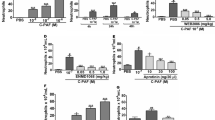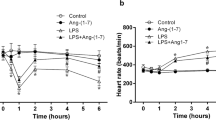Abstract
Platelet-activating factor (PAF) induces pulmonary edema and has a key role in acute lung injury (ALI). Here we show that PAF induces pulmonary edema through two mechanisms: acid sphingomyelinase (ASM)-dependent production of ceramide, and activation of the cyclooxygenase pathway. Agents that interfere with PAF-induced ceramide synthesis, such as steroids or the xanthogenate D609, attenuate pulmonary edema formation induced by PAF, endotoxin or acid instillation. Our results identify acid sphingomyelinase and ceramide as possible therapeutic targets in acute lung injury.
This is a preview of subscription content, access via your institution
Access options
Subscribe to this journal
Receive 12 print issues and online access
$209.00 per year
only $17.42 per issue
Buy this article
- Purchase on SpringerLink
- Instant access to full article PDF
Prices may be subject to local taxes which are calculated during checkout






Similar content being viewed by others
References
Paris, F. et al. Endothelial apoptosis as the primary lesion initiating intestinal radiation damage in mice. Science 293, 293–297 (2001).
Grassme, H. et al. CD95/CD95 ligand interactions on epithelial cells in host defense to Pseudomonas aeruginosa. Science 290, 527–530 (2000).
Chang, S.W., Feddersen, C.O., Henson, P.M. & Voelkel, N.F. Platelet-activating factor mediates hemodynamic changes and lung injury in endotoxin-treated rats. J. Clin. Invest. 79, 1498–1509 (1987).
Miotla, J.M., Jeffery, P.K. & Hellewell, P.G. Platelet-activating factor plays a pivotal role in the induction of experimental lung injury. Am. J. Respir. Cell Mol. Biol. 18, 197–204 (1998).
Falk, S. et al. Quinolines attenuate PAF-induced pulmonary pressor responses and edema formation. Am. J. Respir. Crit. Care Med. 160, 1734–1742 (1999).
Nagase, T. et al. Platelet-activating factor mediates acid-induced lung injury in gentically engineered mice. J. Clin. Invest. 104, 1071–1076 (1999).
Carter, M.B., Wilson, M.A., Wead, W.B. & Garrison, R.N. Platelet-activating factor mediates pulmonary macromolecular leak following intestinal ischemia-reperfusion. J. Surg. Res. 60, 403–408 (1996).
Tjoelker, W. et al. Anti-inflammatory properties of a platelet-activating factor acetyl hydrolase. Nature 374, 549–553 (1995).
Schuster, D.P. et al. Recombinant platelet-activating factor acetylhydrolase to prevent acute respiratory distress syndrome and mortality in severe sepsis: phase IIb, multicenter, randomized, placebo-controlled, clinical trial. Crit. Care Med. 31, 1612–1619 (2003).
Dodam, J.R., Olson, N.C. & Friedman, M. Differential effects of tumor necrosis factor-α and platelet-activating factor on bovine pulmonary artery endothelial cells in vitro. Exp. Lung Res. 20, 131–141 (1994).
Tschugguel, W., Zhegu, Z., Gajdzik, L., Maier, M. & Graf, J. High precision measurement of electrical resistance across endothelial cell monolayers. Pflügers Arch. 430, 145–147 (1995).
Bessin, P. et al. Acute circulatory collapse caused by platelet-activating factor (PAF-acether) in dogs. Eur. J. Pharmacol. 86, 403–413 (1983).
Uhlig, S. The isolated perfused lung. in Methods in Pulmonary Pharmacology (eds. Uhlig, S. & Taylor, A.E.) 29–55 (Birkhäuser, Basel, 1998).
Göggel, R., Hoffman, S., Nüsing, R., Narumiya, S. & Uhlig, S. PAF-induced pulmonary edema is partly mediated by PGE2, EP3-receptors and potassium channels. Am. J. Respir. Crit. Care Med. 166, 657–662 (2002).
Balsinde, J., Balboa, M.A. & Dennis, E.A. Inflammatory activation of arachidonic acid signaling in murine P388D1 macrophages via sphingomyelin synthesis. J. Biol. Chem. 272, 20373–20377 (1997).
Tabas, I. Secretory sphingomyelinase. Chem. Phys. Lipids 102, 123–130 (1999).
Wong, M.L. et al. Acute systemic inflammation up-regulates secretory sphingomyelinase in vivo: a possible link between inflammatory cytokines and atherogenesis. Proc. Natl. Acad. Sci. USA 97, 8681–8686 (2000).
Grassmé, H. et al. CD95 signaling via ceramide-rich membrane rafts. J. Biol. Chem. 276, 20589–20596 (2001).
Cremesti, A. et al. Ceramide enables Fas to cap and kill. J. Biol. Chem. 276, 23954–23961 (2001).
Vielhaber, G. et al. Mouse anti-ceramide antiserum: a specific tool for the detection of endogenous ceramide. Glycobiology 11, 451–457 (2001).
Vielhaber, G. et al. Localization of ceramide and glucosylceramide in human epidermis by immunogold electron microscopy. J. Invest. Dermatol. 117, 1126–1136 (2001).
Cowart, L.A., Szulc, Z., Bielawska, A. & Hannun, Y.A. Structural determinants of sphingolipid recognition by commercially available anti-ceramide antibodies. J. Lipid Res. 43, 2042–2048 (2002).
Uhlig, S., Wollin, L. & Wendel, A. Contributions of thromboxane and leukotrienes to platelet-activating factor-induced impairment of lung function in the rat. J. Appl. Physiol. 77, 262–269 (1994).
Brade, L., Holst, O. & Brade, H. An artificial glycoconjugate containing the bisphosphorylated glucosamine disaccharide backbone of lipid A binds lipid A monoclonal antibodies. Infect. Immun. 61, 4514–4517 (1993).
Wright, S.D. & Kolesnick, R.N. Does endotoxin stimulate cells by mimicking ceramide? Immunol. Today 16, 297–302 (1995).
Schütze, S. et al. TNF activates NF-κB by phosphatidylcholine-specific phospholipase C-induced “acidic” sphingomyelin breakdown. Cell 71, 765–776 (1992).
Luberto, C. & Hannun, Y.A. Sphingomyelin synthase, a potential regulator of intracellular levels of ceramide and diacylglycerol during SV40 transformation. Does sphingomyelin synthase account for the putative phosphatidylcholine-specific phospholipase C? J. Biol. Chem. 273, 14550–14559 (1998).
Albouz, S., Le Saux, F., Wenger, D., Hauw, J.J. & Baumann, N. Modifications of sphingomyelin and phosphatidylcholine metabolism by tricyclic antidepressants and phenothiazines. Life Sci. 38, 357–363 (1986).
Hurwitz, R., Ferlinz, K. & Sandhoff, K. The tricyclic antidepressant desipramine causes proteolytic degradation of lysosomal sphingomyelinase in human fibroblasts. Biol. Chem. Hoppe Seyler. 375, 447–450 (1995).
Boschetto, P., Rogers, D.F., Fabbri, L.M. & Barnes, P.J. Corticosteroid inhibition of airway microvascular leakage. Am. Rev. Respir. Dis. 143, 605–609 (1991).
Chae, H.J. et al. Dexamethasone suppresses tumor necrosis factor-α-induced apoptosis in osteoblasts: possible role for ceramide. Endocrinology 141, 2904–2913 (2000).
Koval, M. & Pagano, R.E. Intracellular transport and metabolism of sphingomyelin. Biochim. Biophys. Acta 1082, 113–125 (1991).
Taylor, A.E., Khimenko, P.L., Moore, T.M. & Adkins, W.K. Fluid balance. in The Lung: Scientific Foundations 2nd ed. (eds. Crystal, R.G., West, J.B., Weibel, E.R. & Barnes, P.J.) 1549–1580 (Lipincott-Raven, Philadelphia, 1997).
Haimovitz-Friedman, A. et al. Lipopolysaccharide induces disseminated endothelial apoptosis requiring ceramide generation. J. Exp. Med. 189, 1831–1841 (1997).
Hannun, Y.A. & Luberto, C. Ceramide in the eukaryotic stress response. Trends Cell Biol. 10, 73–80 (2000).
Venkataraman, K. & Futerman, A.H. Ceramide as a second messenger: sticky solutions to sticky problems. Trends Cell Biol. 10, 408–412 (2000).
Machleidt, T. et al. Function of the p55 tumor necrosis factor receptor “death domain” mediated by phosphatidylcholine-specific phospholipase C. J. Exp. Med. 184, 725–733 (1996).
Uhlig, S. & Wollin, L. An improved setup for the isolated perfused rat lung. J. Pharm. Tox. Meth. 31, 85–94 (1994).
Imai, Y. et al. Injurious mechanical ventilation and end-organ epithelial cell apoptosis and organ dysfunction in an experimental model of acute respiratory distress syndrome. JAMA 289, 2104–2112 (2003).
Evans, T.W., Chung, K.F., Rogers, D.F. & Barnes, P.J. Effect of platelet-activating factor on airway vascular permeability: possible mechanisms. J. Appl. Physiol. 63, 479–484 (1987).
Bligh, E.G. & Dyer, W.J. A rapid method of total lipid extraction and purification. Can. J. Biochem. Physiol. 37, 912 (1959).
Rustenbeck, I. & Lenzen, S. Quantitation of hexadecylphosphocholine by high-performance thin-layer chromatography with densitometry. J. Chromatogr. 525, 85–91 (1990).
Hayter, H. & Hannun, Y.A. Analyzing the sphingomyelin cycle: protocols for measuring sphingomyelinase, sphingomyelin and ceramide in Lipid Second Messengers (eds. Laylock, S.G., Rubin, R.P. & Rasman, G.D.) 17–32 (CRC Press, Boca Raton, 1999).
Wiegmann, K., Schütze, S., Machleidt, T., Witte, D. & Krönke, M. Functional dichotomy of neutral and acidic sphingomyelinases in tumor necrosis factor signaling. Cell 78, 1005–1015 (1994).
Benjamini, Y. & Hochberg, Y. Controling the false rate: a practical and powerful approach to multiple testing. J. R. Statist. Soc. 57, 289–300 (1995).
Acknowledgements
This study was supported by Deutsche Forschungsgemeinschaft grants SFB 367/A9 to S.U., SFB 367/C9 to S.E., SFB 415/A11 to S.S. and DFG Gu 335/10-2/3 to E.G. We thank S. Schnell (Borstel) and F. Seel (Borstel) for technical assistance.
Author information
Authors and Affiliations
Corresponding author
Ethics declarations
Competing interests
H.B. is the managing director of Glycobiotech GmbH, from which the IgM-enriched mouse serum against ceramide was obtained. The monoclonal antibody was obtained from Alexis.
Rights and permissions
About this article
Cite this article
Göggel, R., Winoto-Morbach, S., Vielhaber, G. et al. PAF-mediated pulmonary edema: a new role for acid sphingomyelinase and ceramide. Nat Med 10, 155–160 (2004). https://doi.org/10.1038/nm977
Received:
Accepted:
Published:
Issue Date:
DOI: https://doi.org/10.1038/nm977
This article is cited by
-
Role of ASM/Cer/TXNIP signaling module in the NLRP3 inflammasome activation
Lipids in Health and Disease (2021)
-
Sphingolipids as a Novel Therapeutic Target in Radiation-Induced Lung Injury
Cell Biochemistry and Biophysics (2021)
-
Concomitant deletion of HRAS and NRAS leads to pulmonary immaturity, respiratory failure and neonatal death in mice
Cell Death & Disease (2019)
-
Imipramine blocks acute silicosis in a mouse model
Particle and Fibre Toxicology (2017)
-
Signalling mechanisms in PAF-induced intestinal failure
Scientific Reports (2017)



